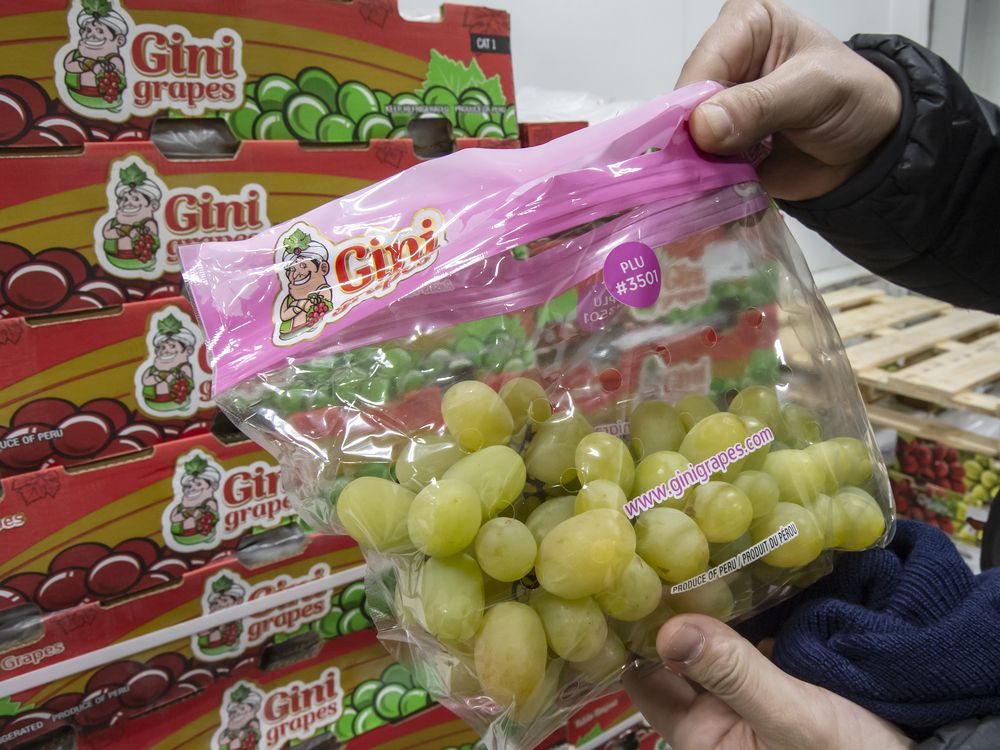To fully grasp the current crisis in the flow of goods, you’ve got to watch a box of something struggle its way through
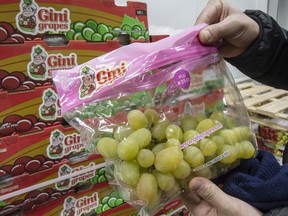
Article content
A load of Peruvian green grapes arrived in west-end Toronto in the afternoon. The truck backed up to a cold storage facility off the highway and a team of inspectors collected its samples and began its tests.
Advertisement
This advertisement has not loaded yet, but your article continues below.
Article content
The inspectors, employed by the pre-eminent Canadian grape importer, North American Produce Buyers Ltd., checked for scars, splits and shrivelling. They looked for straggly bunches, brown stems and those loose grapes that fall to the bottom of the bag — a defect known in the industry as “shatter.” They squeezed juice into a machine that checks sugar content, and used a set of metal sizing rings to determine whether the grapes were extra large, as promised, which requires a diameter of at least 14/16ths of an inch for this variety.
For the grapes themselves, the stakes are incredibly high. In the international fruit trade, bad grapes mean insurance claims and legal disputes. But more importantly, the tests determine whether the grapes will do what they were grown to do: Feed people in Canada, and other cold places.
Advertisement
This advertisement has not loaded yet, but your article continues below.
Article content
Canada’s dependence on imported food has become a national fixation this winter, as the Omicron wave drove global supply chains deeper into chaos and online photos of empty grocery shelves ratcheted up panic. Five federal cabinet ministers hosted a national supply chain summit on Jan. 31, while in and around Parliament Hill, protesters continued to call for an end to COVID-19 public health regulations.
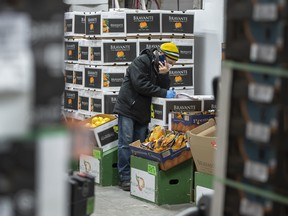
Before that protest became an international spectacle, it was a show of frustration with a federal regulation that requires truckers crossing into Canada to be vaccinated. Lobby groups and industry leaders warned that any reduction in truck drivers would it harder to get critical goods across the border, since the industry was already struggling with a labour shortage.
Advertisement
This advertisement has not loaded yet, but your article continues below.
Article content
But if you focus too closely on trucking, you miss the rest of the mess. The current crisis in the worldwide flow of goods is much more than one controversy or chokepoint, and to fully grasp it, you’ve got to watch a box of something struggle its way through.
(Click here to see graphic below at full size.)
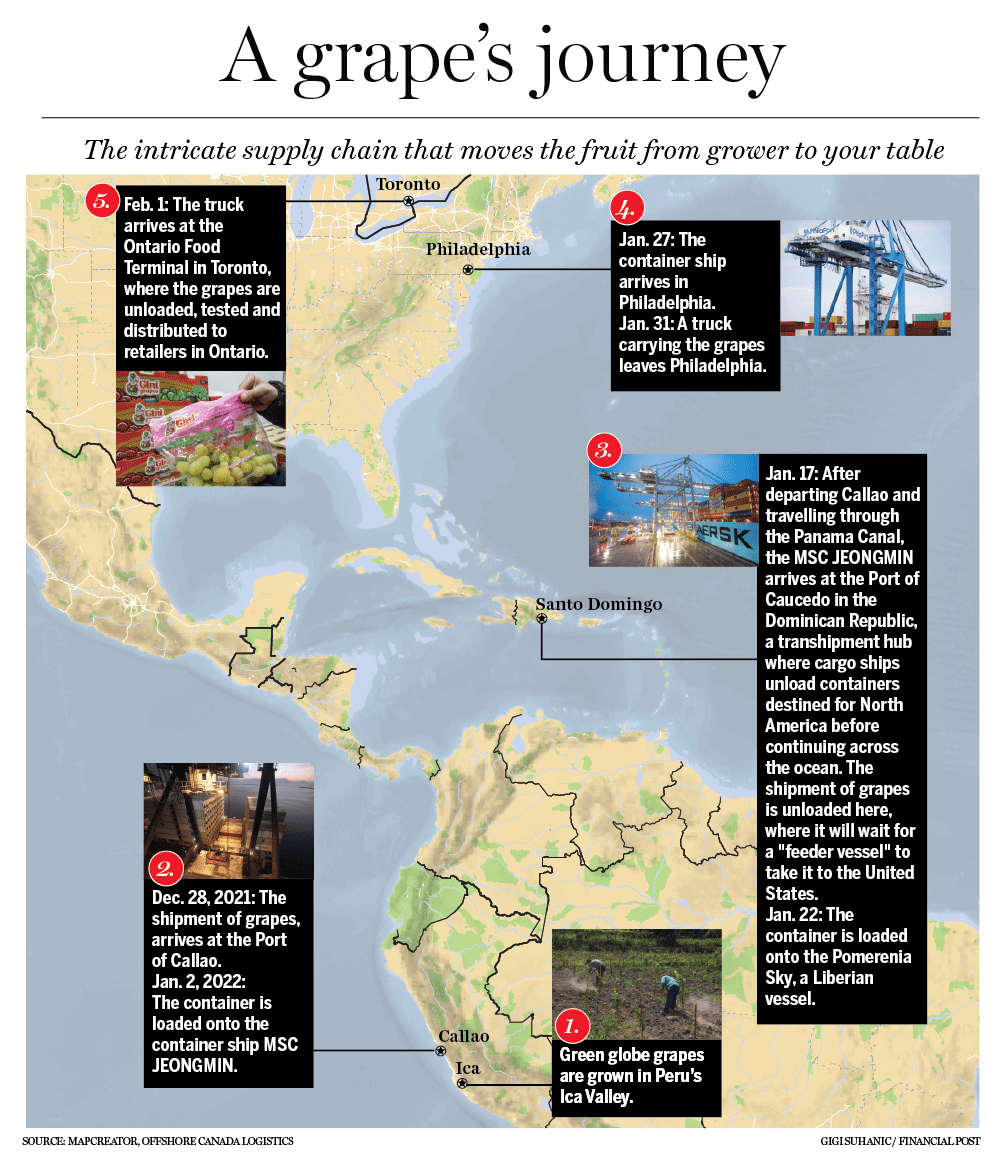
Dec. 21, 2021: Our grapes are packed
Pallet E21A00589 weighed 738 kilograms, which is roughly the same as a racehorse jockeyed by a large black bear. It was stacked with 90 cases of IGF TEN — a breed of seedless, green table grapes trademarked under the name Sweet Globe. International Fruit Genetics, the California breeding company that engineered the Sweet Globes, promises its creations will be thin-skinned and “delightfully crunchy.” The kind that snap when you bite them.
Advertisement
This advertisement has not loaded yet, but your article continues below.
Article content
Importing grapes to Canada works on a loop, cycling from one major growing region to another as the seasons change. You start with California, which can provide good grapes until mid-winter, then you move to Peru. South Africa starts shortly after that, then Chile and by the time those regions are slowing down, Mexico is in full swing.
About a week before Christmas, Pallet E21A00417 was harvested and packed. Agricola Andrea, a major grower and exporter based in Peru’s Ica Valley, packaged the Sweet Globes in retail-ready bags bearing its Grape Gini brand, with a little cartoon genie in the top corner.
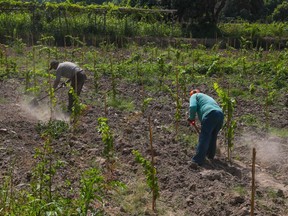
It was something of a miracle the pallets of grapes were loaded onto a container at all. Refrigerated containers — reefers, in industry-speak — are more complicated than the regular boxes and they’re in high demand during the growing season in Peru.
Advertisement
This advertisement has not loaded yet, but your article continues below.
Article content
Mediterranean Shipping Company SA (MSC) a major global container shipping line that transported the load of grapes, said reefers are subject to “rigorous pre-trip checks” to make sure they’re working correctly. Reefer cargo is sensitive and any equipment malfunction puts the entire lot at risk. But the checks take time, and grapes have only so much time before their quality starts to degrade.
Dec. 28, 2021: Our grapes are cleared to arrive at Port of Callao, Peru
Workers have been calling in sick with the Omicron variant at each level of the supply chain, including ports. That has exacerbated labour shortages and delays in the shipping business, slowing down the flow of goods at a time when the system is dealing with a surge in demand. Whenever there’s a COVID-19 outbreak on a ship, it has to be kept in quarantine until local authorities give it clearance to resume its voyage, causing even more delays, MSC said.
Advertisement
This advertisement has not loaded yet, but your article continues below.
Article content
The international shipping system was already operating around max capacity before the pandemic. Shipping companies were reluctant to add too much capacity, for fear that oversupply could deflate shipping rates, said Jonathan Roach, a container market analyst at the London shipbroking firm Braemar ACM.
You have a system under strain that is being asked to carry more than it was designed to carry
Phil Levy
During the pandemic, pressure on the shipping industry got more intense as U.S. household spending shifted from services to goods, said Phil Levy, chief economist at Flexport Inc., a San Francisco-based logistics software firm. The extra demand stretched the system thinner and thinner, and delays started to compound. A ship stuck at anchor, waiting for a berth at a port, meant delays in its next voyage, and likely the next one after that. Freak incidents, such as the blockage that shut down the Suez Canal for almost a week in March 2021.
Advertisement
This advertisement has not loaded yet, but your article continues below.
Article content
“You have a system under strain that is being asked to carry more than it was designed to carry,” Levy said.
Rates to ship containers this month are up 125 per cent over this time last year, according to Braemar.
Jan. 2, 2022: Our grapes are loaded onto the MSC JEONGMIN
The MSC Jeongmin is longer than a city block, with capacity to carry 7,100 loaded 20-foot shipping containers.
Sandro Saragiotto, president of Offshore Canada Logistics Inc., started tracking the shipment from the time the boat left the port. North American Produce Buyers is the majority owner in Offshore Logistics, and uses the company to manage the flow of its fruit imports.
“Before I used to spend, I don’t know, half an hour on those containers,” he said. “Now, I spend like two, three hours on each container after it leaves the port. Just to keep it up, finding where it is, where it’s getting stuck, putting pressure.”
Advertisement
This advertisement has not loaded yet, but your article continues below.
Article content
Jan. 17, 2022: Our grapes are unloaded at Port of Caucedo, Dominican Republic
Caucedo is a popular hub where container ships offload their North America-bound freight before crossing the Atlantic, known as a transshipment port. The Jeongmin left the grapes to wait for a feeder vessel, and headed for Belgium.
MSC said heavy congestion at transshipment ports, due to the “overall volumes moving during COVID,” has further delayed transit times from Peru to the United States.

Larry Davidson, owner of North American Produce Buyers, said his U.S.-bound cargo from South America has waited in transshipment hubs for as long as three weeks before finally being loaded onto a feeder vessel.
Davidson, who has worked in his family’s business for 24 years, said part of the job has always been reacting to some sort of nonsense: a weather disaster, or “oddball outliers” like the time a container frozen to the hull of a ship needed blowtorches to free it. His dad used to say that it’s what makes the business interesting.
Advertisement
This advertisement has not loaded yet, but your article continues below.
Article content
But this year, the oddball outliers and interruptions have kept coming, causing a wave of delays, each problem pushing the wave up and up and up.
“It’s gone off the rails,” he said. “I could settle for a little less interesting.”
Jan. 22, 2022: Our grapes are loaded onto Pomerania Sky, bound for Philadelphia
The Pomerania Sky, a smaller vessel owned by a German shipping company, was chartered by MSC to complete the voyage, up the eastern coast of the U.S. to Philadelphia.
“That was a very fast one actually,” said Saragiotto, the logistics expert.
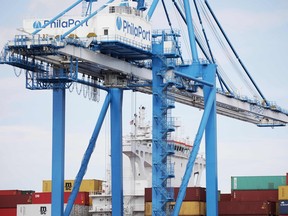
MSC said in an email that voyages between Peru and Philadelphia used to take about 15 days before the pandemic, plus another day or two for the cargo to reach Toronto or Montreal by truck. Now, it’s an average of 25 days to Philadelphia and an extra five or six days to Canada, “given the lack of truck power and the current vaccination mandates for the cross-border trucking community,” MSC said in a statement on Jan. 26.
Advertisement
This advertisement has not loaded yet, but your article continues below.
Article content
Jan. 27, 2022: Our grapes reach Philadelphia
By now, the grapes have sailed two seas, on two ships, through a handful of major ports, across two continents, and if their stems are too brown, if their flesh is too blemished, if they aren’t as crunchy as expected, this great voyage could end at the bottom of a garbage bin, or wallowing unloved on a retail shelf or in a crisper drawer.
“It’s not just the journey of the grapes, but what the grapes represent,” said Alison Blay-Palmer, director of the Laurier Centre for Sustainable Food Systems.
It’s not just the journey of the grapes, but what the grapes represent
Alison Blay-Palmer
Shipping fruit halfway across the world has consequences, both for the environment and the workers on the ground, she said. Peru, for example, has seen massive strikes in recent years as farmworkers pushed for higher wages. And more than a third of human-made greenhouse gas emissions are caused by global food systems, according to a report from the United Nations’ Food and Agriculture Organisation (FAO). In November, FAO said the act of transporting food across supply chains is on course to overtake farming and land use as the largest polluter in the agri-food system.
Advertisement
This advertisement has not loaded yet, but your article continues below.
Article content
Food systems scholars have also warned that the system won’t work forever. Climate change is likely to pose serious questions to major growing regions, with more frequent weather disasters like the extreme drought that impacted crop yields across California and much of western North America last summer.
Can we really afford to take water out of California and drive it to Vancouver?” said Evan Fraser, director of the Arrell Food Institute at the University of Guelph. “That’s essentially what fruit and vegetable trade is. Can we really do that? That’s 20th-century thinking.”
Jan. 31, 2022: Our grapes are loaded onto a truck
The price of a truck from Philadelphia to Toronto is all over the place. In previous years, a truckload of grapes from the U.S. to Toronto cost between US$1,600 and US$2,200, said Davidson at North American Produce Buyers.
Advertisement
This advertisement has not loaded yet, but your article continues below.
Article content
This year, however, shortages in truck drivers and supply backlogs have raised the price to as much as US$4,500, he said. “It’s basically: Someone offers a truck, we take it,” he said. “Whatever (the price) is, it is.”
The added costs of both shipping and trucking have had contributed to fruit costs for Canadian consumers.

In its latest consumer price index report, Statistics Canada found that prices of “other fruit,” which includes grapes, berries, melons and pears, increased by 5.6 per cent in December compared with a year earlier.
Gary Sands, senior vice-president of the Canadian Federation of Independent Grocers, said fruit and vegetables have been the most difficult category to keep in stock due to supply chain issues this winter. And delays in transport have taken the biggest toll on independent stores. “If the Four Horsemen of the Apocalypse pulled into an independent grocer’s parking lot, they would just look out the window and think it was another day.”
Advertisement
This advertisement has not loaded yet, but your article continues below.
Article content
Feb. 1, 2022: Our grapes arrive at the Ontario Food Terminal
Around 4 a.m., driving in west-end Toronto is a dream. It’s quiet and empty, which makes pulling into the Ontario Food Terminal all the more jarring. It’s a hidden city, a little Atlantis off the Queensway that discretely serves as the entry point for much of the fruit and vegetables distributed in Ontario. The place has its own police force, and a freeway for motorized pallet jacks.
Importers and wholesalers bring in the produce and operate stalls, known as houses, where buyers come to pick out pallets of product for local, independent retailers.
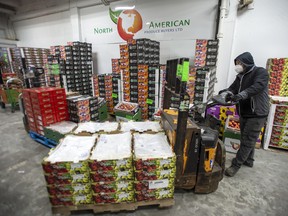
To be a new visitor to one of the houses, in the middle of the daily trade, is to be constantly in the way. It’s a nauseous feeling. You zag out of a path of a forklift, and you’re butting into a heated discussion between fruit salesmen.
Advertisement
This advertisement has not loaded yet, but your article continues below.
Article content
On a recent morning, one salesman shouted at another, cursing. He ran his thumb across his throat.
The other salesman, who just walked away casually, later explained that when supply is tight, “tempers flare.”
The cases of fruit, stacked along both sides of the stall with a thin lane in the middle, were not as abundant as they’d normally be, said Juan Veliz, a Chilean agronomist who heads up the company’s quality control department.
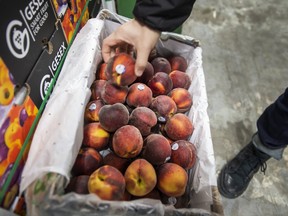
Most houses in the terminal are known for specializing in something. One house does bananas and tropical fruit, another does citrus. North American Produce is known to be very good at grapes.
Veliz likes to say grapes are alive. “They’re breathing,” he said recently, explaining the different respiration rates of different fruit. But to be alive, really, is to be decaying, and while a refrigerated shipping container set to zero degrees Celsius is supposed to slow all that down, you still have to dig and test to be certain it worked.
Advertisement
This advertisement has not loaded yet, but your article continues below.
Article content
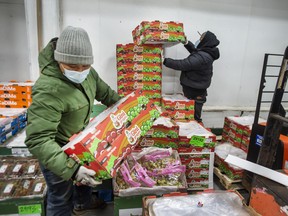
The container from Peru arrived on Feb. 1. Veliz’s team collected two digital probes from the box, one at the front, another at the back, that had been monitoring the temperature since the grapes were packed in December.
In his closet-sized basement office at the terminal, Veliz uploads data from the probes and can follow the fluctuations on a graph. You don’t want to see spikes, he said, just a steady line hovering around zero degrees. When things go wrong with his fruit, the temperature graph can give clues about what happened. Veliz’s computer is full of condition and quality reports, documenting problems like chill damage, with photos of grapes turned purple-blue like frozen lips.
Upstairs, his team took a sample case from Pallet E21A00589 and dumped it out on a metal table and started checking for defects. Their report noted the fruit was packed 45 days prior. The sugar content was an acceptable 18.3 per cent. The inspectors found 179 grams of shatter, which, when calculated as a percentage of the whole, wasn’t enough to drag down the fruit’s overall rating. The pallet scored a “1,” or “very good” — the best of North American’s four grades for grapes.
Advertisement
This advertisement has not loaded yet, but your article continues below.
Article content
-

Trucker vaccine mandate protest snarls Canada-U.S. border crossing for fifth day
-

Jason Kenney calls on Trudeau, Biden to ‘exercise common sense’ on truckers vaccine mandate
-

‘Turning into a crisis’: Jason Kenney working with U.S. governors to end trucker vaccine mandates
-

Canada’s trucker vaccine rule is making freight and fruit pricier
North American works on a consignment basis with large exporters around the world. The company brings in shipments of fruit, sells them to a retailer in Canada, and takes a commission. This week, very good Green Globes were going for about $44 to $72 a case, which means Pallet E21A00589 would have likely sold for as much as $6,480. North American sent the grapes to a major grocer’s distribution warehouses in the Toronto area, though the company declined to identify which store.
Veliz’s office is scattered with fruit tools. He has a black plastic device that measures the circumference of citrus, a long serrated pocket knife and somewhere, he said, there was an expensive little machine that can measure the firmness of a grape.
After the Sweet Globes came in, he took a bag from the shipment and looked them over. They were bright and cold. “Those are the best that there are,” he said.
Financial Post
• Email: jedmiston@postmedia.com | Twitter: jakeedmiston
Advertisement
This advertisement has not loaded yet, but your article continues below.

